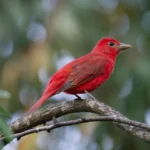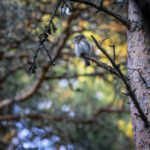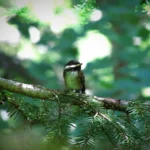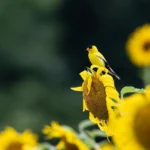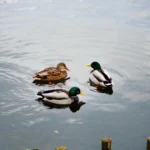Michigan, with its varied landscapes of forests, lakes, and wetlands, offers an ideal habitat for numerous bird species. Among these avian residents, blue birds hold a special place, captivating birdwatchers and nature enthusiasts alike with their vivid hues and melodic songs. In this comprehensive article, we will explore the blue birds commonly found in Michigan, their unique characteristics, habitats, and behaviors. We will also delve into the fascinating subject of Blue and Orange Bird Michigan, highlighting the species that showcase this striking color combination.
Table of Contents
Blue Birds in Michigan
Blue birds are a group of avian species distinguished by their striking blue plumage. Michigan’s diverse ecosystem supports a variety of blue bird species, some of which are year-round residents, while others are seasonal visitors. Let’s take a closer look at some of the most prominent blue birds in the state:
Indigo Bunting
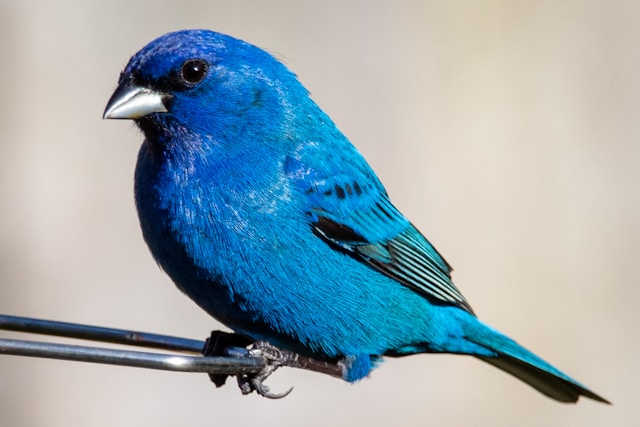
The Indigo Bunting (Passerina cyanea) has a life expectancy of 8 to 10 years in the wild. Their survival depends on food availability, predation, and environmental factors.
Size:
This small songbird measures 4.5 to 5.1 inches in length, making it smaller than the Blue Grosbeak but similar in size to other buntings.
Weight:
The Indigo Bunting is a lightweight bird, weighing between 0.4 and 0.6 ounces, which allows for agile and efficient flight.
Wingspan:
Its wingspan ranges from 7.1 to 9.1 inches, enabling swift movement and strong migratory abilities.
Status:
Listed as Least Concern, the Indigo Bunting has a stable population, benefiting from its adaptability to various habitats.
Identification:
Males are a striking brilliant blue, while females are brown with faint streaks, providing them with camouflage.
Habitat:
It inhabits woodland edges, fields, and brushy areas, often found near open spaces with dense vegetation.
Behavior:
Males sing rich, melodious songs from high perches to defend territories. Indigo Buntings are nocturnal migrants, traveling long distances at night.

Blue Jay
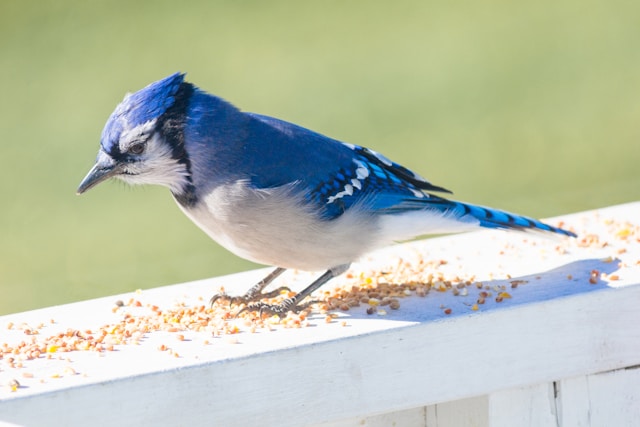
Life Span:
The Blue Jay (Cyanocitta cristata) has an average lifespan of about seven years in the wild. However, in captivity, where they are protected from predators and harsh environmental conditions, they can live up to 17 years.
Size:
These birds typically measure between 9 to 12 inches in length. Their size makes them easily recognizable, especially with their striking blue plumage and crest.
Weight:
Blue Jays weigh between 2.5 to 3.5 ounces. Their relatively light body allows them to be agile and quick in flight.
Wingspan:
The wingspan of a Blue Jay ranges from 13 to 17 inches. This broad wingspan aids in their strong and graceful flight.
Status:
Blue Jays are classified as “Least Concern” by conservation organizations. Their population remains stable due to their adaptability to different environments.
Identification:
They are blue with white underparts, a black necklace around their neck, and a distinctive crest on their head.
Habitat:
Blue Jays inhabit forests, suburban areas, and parks. They are highly adaptable to both natural and urban settings.
Behavior:
These birds are highly intelligent, capable of mimicking other bird calls. They are also known for storing acorns for future use, playing a role in forest regeneration.
Also Read : Discover 11 Types of Hawks in Tennessee
Belted Kingfisher
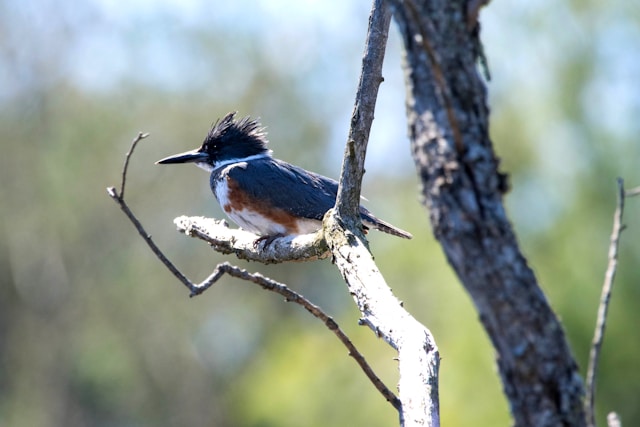
Life Span:
The Belted Kingfisher (Megaceryle alcyon) typically lives between 6 to 10 years in the wild. Their lifespan can be affected by environmental conditions, food availability, and predation.
Size:
These birds measure between 11 to 14 inches in length. Their size, along with their distinctive head shape and large bill, makes them easy to identify.
Weight:
Belted Kingfishers weigh between 4.5 to 6.3 ounces. Their relatively lightweight body helps them stay agile for diving into the water to catch fish.
Wingspan:
With a wingspan ranging from 19 to 23 inches, Belted Kingfishers are strong fliers, capable of hovering briefly before plunging into the water.
Status:
They are classified as “Least Concern” due to their stable population. However, habitat destruction can pose a threat to their numbers.
Identification:
Belted Kingfishers have a large head with a shaggy crest, blue-gray upperparts, and a distinctive white collar around the neck.
Habitat:
They are commonly found near rivers, lakeshores, and streams, where they rely on freshwater bodies for food.
Behavior:
These birds are expert fishers, often diving headfirst into the water to catch fish. They also nest in burrows along riverbanks, digging tunnels into soft soil.
Also Read : Discover Blue Birds in Pennsylvania: Where and How to Spot Them
Tree Swallow
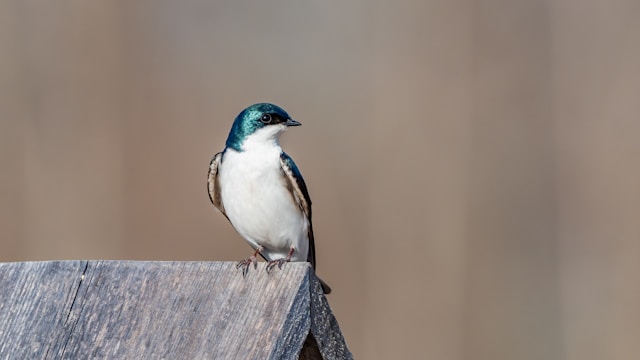
Life Span:
The Tree Swallow (Tachycineta bicolor) has a lifespan of about 2 to 6 years in the wild. Their survival depends on factors such as predation, weather conditions, and food availability.
Size:
These small birds measure between 4.7 to 5.9 inches in length. Their compact size makes them highly agile in flight.
Weight:
Tree Swallows are lightweight birds, weighing between 0.6 to 0.9 ounces. Their light body structure enables them to perform acrobatic maneuvers in the air.
Wingspan:
With a wingspan of 11.8 to 13.8 inches, Tree Swallows have long, pointed wings that aid in their swift and agile flight.
Status:
They are classified as “Least Concern” due to their widespread population and adaptability to various environments.
Identification:
Tree Swallows have glossy blue upperparts and bright white underparts. Their sleek and iridescent feathers give them a striking appearance in sunlight.
Habitat:
They are commonly found in open fields near water and marshes. They prefer areas with abundant flying insects for food.
Behavior:
Tree Swallows are aerial insectivores, catching insects mid-flight. They nest in tree cavities, nest boxes, and artificial structures, forming small colonies.
Cerulean Warbler
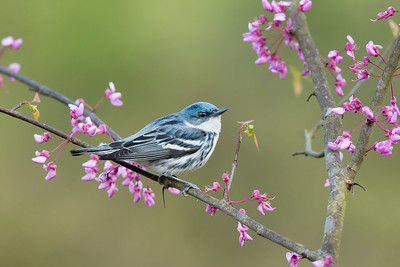
Life Span:
The Cerulean Warbler (Setophaga cerulea) has a lifespan of about six years in the wild. Their survival depends on habitat conditions, predation, and migration challenges.
Size:
These small songbirds measure approximately 4.3 inches in length. Their compact size allows them to move swiftly through the treetops.
Weight:
Cerulean Warblers are extremely lightweight, weighing between 0.3 to 0.4 ounces. Their small body makes them highly agile when foraging for insects.
Wingspan:
With a wingspan of about 7.9 inches, these birds are adept at quick, fluttering flights as they navigate through forest canopies.
Status:
They are classified as “Near Threatened” due to habitat loss and deforestation, particularly in their breeding and wintering grounds.
Identification:
Cerulean Warblers have a sky-blue back, white underparts, and dark streaks on their sides. Males have more vibrant blue plumage, while females are slightly greener.
Habitat:
They prefer mature deciduous forests with tall trees. They are most commonly found in undisturbed woodlands during the breeding season.
Behavior:
These warblers stay high in the forest canopy, where they forage for insects. They are known for their rapid movements and melodic songs during the breeding season.
Black-throated Blue Warbler
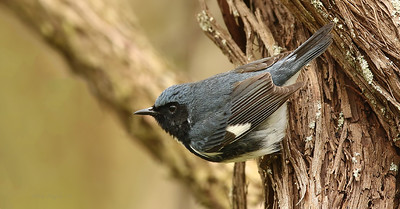
Life Span:
The Black-throated Blue Warbler (Setophaga caerulescens) has a lifespan of about 8 to 10 years. Their longevity depends on factors such as habitat quality, food availability, and predation.
Size:
These small songbirds measure between 4.3 to 5.1 inches in length. Their compact body allows them to move swiftly through dense vegetation.
Weight:
They are very lightweight, weighing between 0.3 to 0.4 ounces. Their small size and agility help them efficiently forage for food in forest undergrowth.
Wingspan:
With a wingspan ranging from 7.5 to 8.3 inches, they have strong, quick wingbeats that allow them to navigate through forest understory.
Status:
The species is classified as “Least Concern” due to stable populations. However, habitat loss remains a threat to their breeding and wintering grounds.
Identification:
Males have a deep blue back, black mask, and white belly, making them easy to identify. Females are more muted in color, with olive-brown upperparts and pale underparts.
Habitat:
Black-throated Blue Warblers prefer deciduous and mixed forests, particularly areas with dense shrubs and understory growth. They thrive in mature woodlands with thick foliage.
Behavior:
These warblers forage in the understory, searching for insects, spiders, and berries. They are active and secretive, often staying low in the vegetation while hunting for food.
Blue and Orange Birds in Michigan
Michigan is home to a few species of birds that exhibit the striking combination of blue and orange plumage. These birds are a visual treat and often draw the attention of birdwatchers.
Barn Swallow
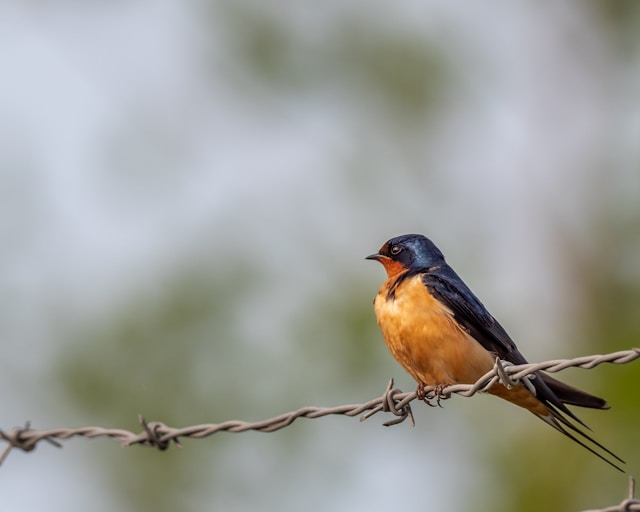
Life Span:
The Barn Swallow (Hirundo rustica) has a lifespan of about 4 to 8 years in the wild. Their survival depends on factors such as food availability, migration challenges, and predation.
Size:
These birds measure between 6.7 to 7.5 inches in length. Their sleek body shape and long wings make them excellent fliers.
Weight:
Barn Swallows are lightweight birds, weighing between 0.6 to 0.7 ounces. Their low body weight enables them to remain airborne for long periods while hunting insects.
Wingspan:
With a wingspan of 11 to 12.6 inches, Barn Swallows have long, pointed wings that allow them to perform acrobatic maneuvers in the air.
Status:
The species is classified as “Least Concern” due to its widespread distribution and stable population. However, habitat destruction and climate change may impact their numbers in certain regions.
Identification:
Barn Swallows have a steel-blue back, rusty orange underparts, and a deeply forked tail. Their streamlined body and long tail feathers make them easy to recognize in flight.
Habitat:
They are commonly found in open fields, farms, and areas near water. They prefer places with plenty of flying insects for food.
Behavior:
Barn Swallows are highly acrobatic fliers, catching insects mid-air with precision. They build cup-shaped mud nests in barns, bridges, and other human structures.
Eastern Bluebird
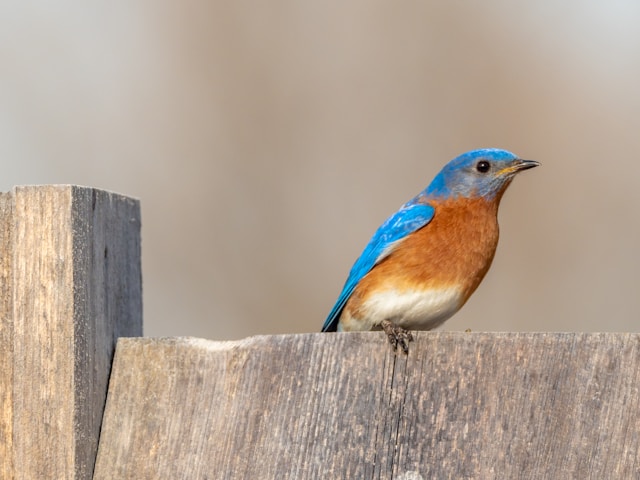
Life Span:
The Eastern Bluebird (Sialia sialis) typically lives between 6 to 10 years in the wild. Their lifespan depends on factors such as predation, weather conditions, and food availability.
Size:
These medium-sized songbirds measure between 6.3 to 8.3 inches in length. Their size allows them to be agile while foraging for food and defending their nesting sites.
Weight:
Eastern Bluebirds weigh between 1 to 1.2 ounces. Their lightweight body helps them maneuver easily through open habitats while searching for insects and fruits.
Wingspan:
With a wingspan of 9.8 to 12.6 inches, they have strong, rounded wings that enable swift and direct flight patterns.
Status:
They are classified as “Least Concern” due to stable populations. Conservation efforts, such as nest box programs, have helped increase their numbers in many areas.
Identification:
Eastern Bluebirds have a bright blue back, an orange chest, and a white belly. Males have more vivid colors, while females are slightly duller with grayish-blue tones.
Habitat:
They thrive in open fields, orchards, and suburban areas with scattered trees and perches. They prefer habitats with access to nesting cavities and abundant food sources.
Behavior:
Eastern Bluebirds nest in natural tree cavities, old woodpecker holes, and nest boxes. They primarily feed on insects but also consume berries and fruits, especially in colder months.
American Kestrel
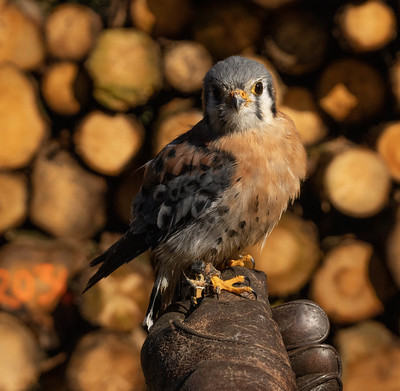
Life Span:
The American Kestrel (Falco sparverius) has a lifespan of about 5 to 10 years in the wild. Their longevity depends on food availability, environmental conditions, and predation risks.
Size:
These small falcons measure between 8.7 to 12.2 inches in length. Despite their small size, they are powerful and agile hunters.
Weight:
American Kestrels weigh between 2.8 to 5.8 ounces. Their lightweight body enables them to hover in place while searching for prey.
Wingspan:
With a wingspan of 20 to 24 inches, they have long, pointed wings that allow for swift and precise flight when hunting.
Status:
They are classified as “Least Concern,” but their populations are declining in some areas due to habitat loss and pesticide use.
Identification:
Males have slate-blue wings, a rusty orange back, and black facial markings. Females have more brownish tones with dark streaks on their undersides.
Habitat:
They prefer open fields, grasslands, and agricultural areas with scattered trees, perches, and access to prey. They often nest in tree cavities and man-made structures.
Behavior:
American Kestrels are skilled hunters, often hovering in the air before diving into prey. They feed on insects, small mammals, and birds, using their sharp talons and beak to catch and kill their food.
Blue Grosbeak
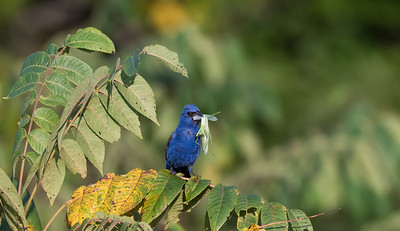
Life Span:
The Blue Grosbeak (Passerina caerulea) has a life expectancy of 6 to 9 years in the wild. Survival depends on factors like predation, habitat quality, and food availability.
Size:
This medium-sized songbird measures 5.5 to 7.5 inches in length, making it slightly larger than other members of the Passerina genus.
Weight:
The Blue Grosbeak weighs between 0.9 and 1.1 ounces, with males typically being slightly heavier than females.
Wingspan:
Its wingspan ranges from 10 to 11 inches, aiding in its swift and agile flight during migration and foraging.
Status:
Classified as Least Concern, the species maintains stable populations, benefiting from its adaptability to different habitats.
Identification:
Males are deep blue with chestnut-orange wing bars, while females and juveniles are brown with a hint of blue.
Habitat:
It prefers shrubby areas, woodland edges, and thickets, often near fields, roadsides, and riparian zones.
Behavior:
The Blue Grosbeak feeds on seeds, insects, and fruits, often singing from high perches and defending its territory aggressively.
Lazuli Bunting
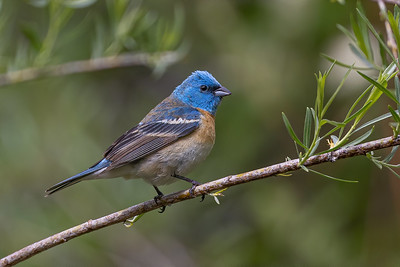
Life Span:
The Lazuli Bunting (Passerina amoena) has a lifespan of about 5 to 9 years in the wild. Their survival is influenced by habitat quality, food availability, and predation.
Size:
These small songbirds measure between 5.1 to 5.9 inches in length. Their compact size allows them to be agile in dense vegetation and open spaces.
Weight:
Lazuli Buntings are lightweight birds, weighing between 0.5 to 0.6 ounces. Their low body weight enables quick, darting flights while foraging.
Wingspan:
With a wingspan of about 8.7 inches, they are efficient flyers, moving swiftly between perches and foraging areas.
Status:
They are classified as “Least Concern” due to stable population levels. However, habitat loss and climate changes could pose future risks.
Identification:
Males have a bright blue head and wings, an orange breast, and a white belly, making them strikingly colorful. Females are more muted, with brownish tones and a hint of blue on the wings.
Habitat:
Lazuli Buntings are commonly found in open woodlands, brushy meadows, and along streams. They prefer habitats with plenty of cover and food sources.
Behavior:
Males sing melodious songs from perches to attract mates and defend territory. They consume a variety of seeds, fruits, and insects, making them adaptable foragers throughout the seasons.
Varied Thrush
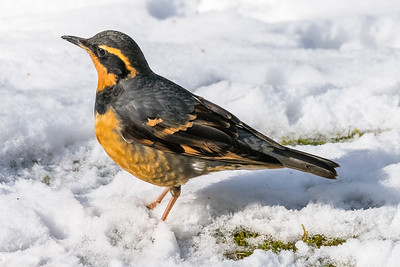
Life Span:
The Varied Thrush (Ixoreus naevius) has a lifespan of about 4 to 7 years in the wild. Their survival depends on factors such as predation, food availability, and environmental conditions.
Size:
These medium-sized songbirds measure between 7.9 to 10.2 inches in length. Their sturdy build and strong legs help them forage efficiently on the forest floor.
Weight:
Varied Thrushes weigh between 2.3 to 3.5 ounces. Their moderate weight allows them to be agile in flight while maintaining strength for ground foraging.
Wingspan:
With a wingspan ranging from 13 to 17 inches, they have broad, powerful wings that enable swift and direct flight through dense forests.
Status:
They are classified as “Least Concern” due to stable populations. However, habitat destruction and climate change could affect their numbers in the future.
Identification:
Varied Thrushes have a slate-blue back, an orange breast, and a black necklace-like band across their chest. Males have more vivid colors, while females have paler markings.
Habitat:
They prefer dense forests, especially in the Pacific Northwest. They are commonly found in coniferous and mixed woodlands with thick undergrowth.
Behavior:
Varied Thrushes are ground foragers, searching for insects, berries, and seeds among leaf litter. They are known for their haunting, flute-like songs, which echo through the forest.
Birdwatching Tips for Blue and Orange Birds in Michigan
If you are eager to observe blue and orange birds in Michigan, consider these tips:
- Best Locations: Visit nature reserves, state parks, and wetlands for the best birdwatching opportunities. Places like Sleeping Bear Dunes, Seney National Wildlife Refuge, and Kensington Metropark are excellent starting points.
- Timing: Early morning is the best time to spot birds as they are most active during this period.
- Equipment: Invest in a good pair of binoculars and a bird guidebook specific to Michigan. A camera with a zoom lens is also helpful for capturing close-up shots.
- Patience: Birdwatching requires patience and quiet observation. Avoid sudden movements or loud noises that might scare the birds away.
- Join Communities: Engage with local birdwatching groups to share experiences and learn from seasoned birders.
Final Thoughts
Michigan’s blue and orange birds add a splash of color and life to the state’s landscapes. Whether you are an avid birdwatcher or a casual nature lover, these birds offer endless opportunities for discovery and appreciation. By fostering conservation efforts and engaging with local birdwatching communities, you can play a part in preserving these avian treasures for generations to come. Happy birdwatching!

Welcome to World Birds Life, where the wonder of birds takes center stage. My name is Lexi, and I’m passionate about helping you discover the beauty and joy that birds bring into our lives.


